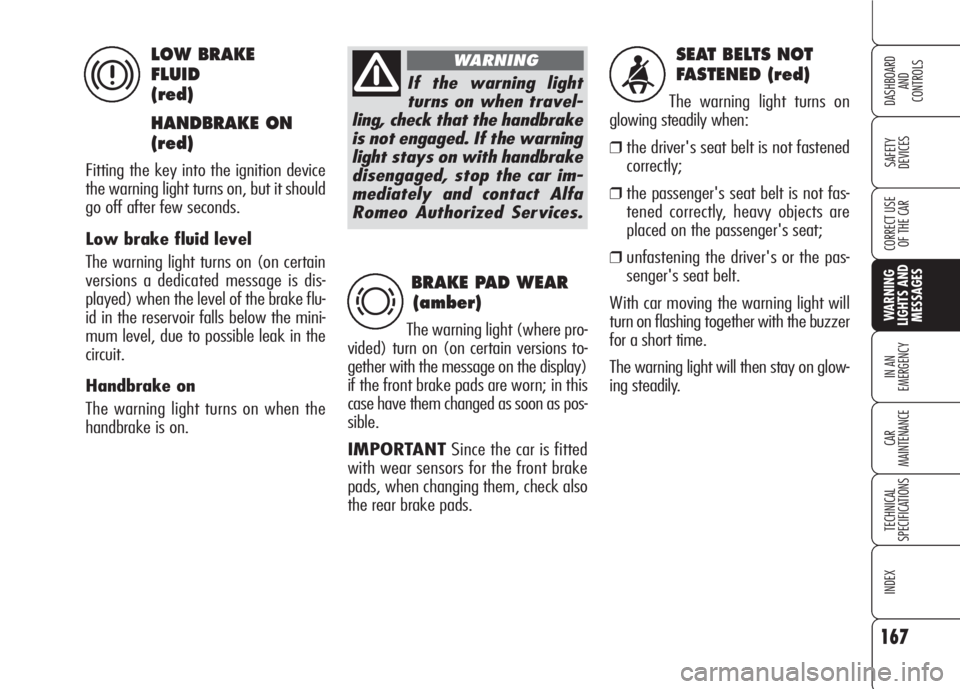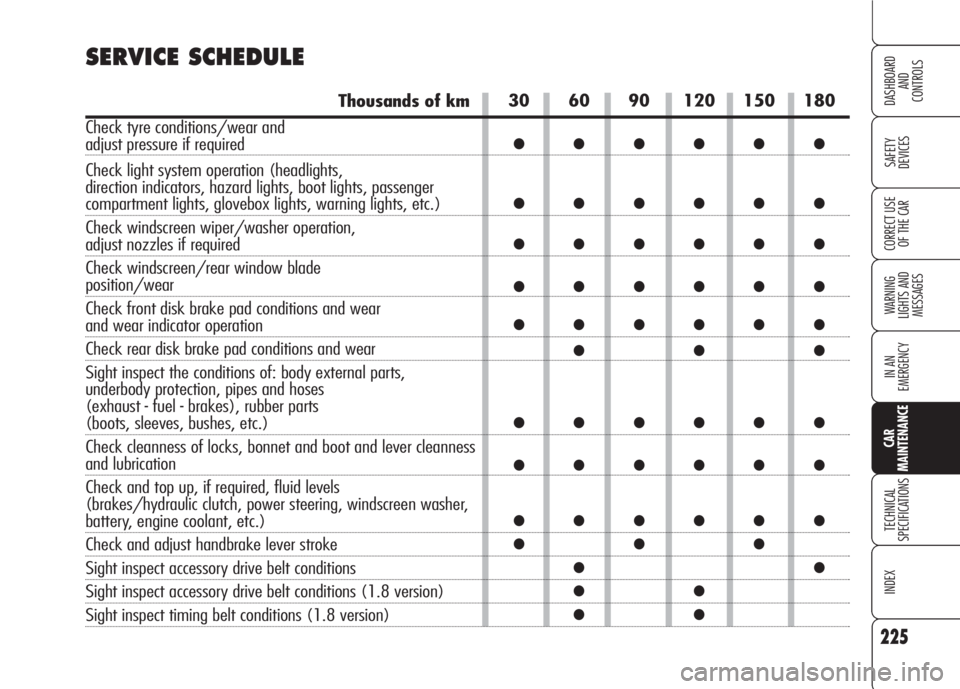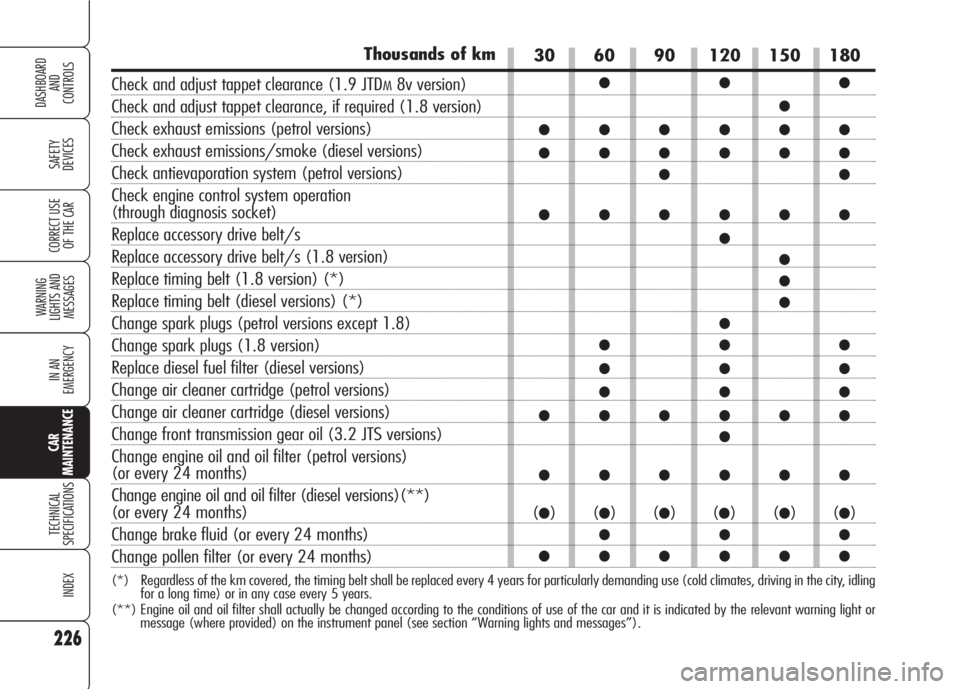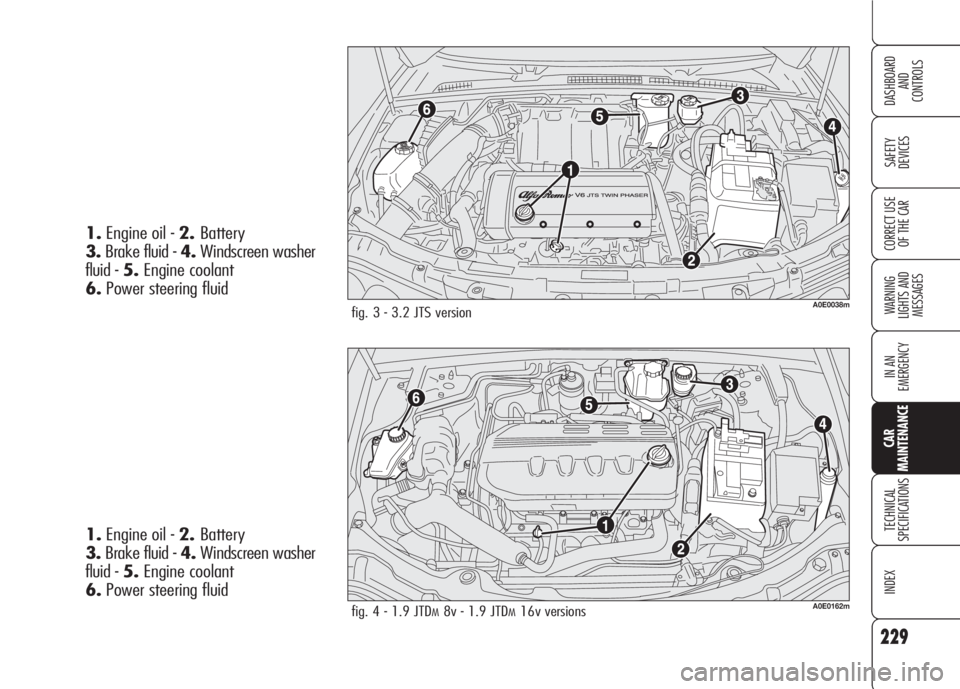brake fluid Alfa Romeo 159 2008 Owner handbook (in English)
[x] Cancel search | Manufacturer: ALFA ROMEO, Model Year: 2008, Model line: 159, Model: Alfa Romeo 159 2008Pages: 303, PDF Size: 5.18 MB
Page 167 of 303

165
SAFETY
DEVICES
IN AN
EMERGENCY
CAR
MAINTENANCE
TECHNICAL
SPECIFICATIONS
INDEX
CORRECT USE
OF THE CAR
DASHBOARD
AND
CONTROLS
WARNING
LIGHTS AND
MESSAGES
W W
A A
R R
N N
I I
N N
G G
L L
I I
G G
H H
T T
S S
A A
N N
D D
M M
E E
S S
S S
A A
G G
E E
S S
LOW BRAKE FLUID/HANDBRAKE ON ..................... 167
BRAKE PAD WEAR ............................................. 167
SEAT BELTS NOT FASTENED ................................. 167
AIR BAG FAILURE................................................ 168
PASSANGER’S FRONT AIR BAGS DEACTIVATED ........ 169
ENGINE COOLANT HIGH TEMPERATURE.................. 169
ENGINE OIL HIGH TEMPERATURE .......................... 170
LOW ENGINE OIL PRESSURE/
EXHAUST OIL..................................................... 170
LOW BATTERY CHARGE ....................................... 170
INCOMPLETE DOOR LOCKING ............................... 171
BONNET OPEN ................................................... 171
BOOT OPEN....................................................... 171
INJECTION SYSTEM FAILURE/
EOBD SYSTEM FAILURE....................................... 171
CAR PROTECTION SYSTEM FAILURE/
STEERING LOCK INHIBITION................................. 172
ALARM FAILURE/BREAK-IN ATTEMPT
ELECTRONIC KEY NOT RECOGNIZED ...................... 172
POSSIBLE PRESENCE OF ICE ON THE ROAD............ 173
PRE-HEATING GLOW PLUGS/
PRE-HEATING GLOW PLUG FAILURE ....................... 173
WATER IN DIESEL FUEL FILTER ............................. 174
INERTIAL FUEL CUT-OFF SWITCHED ON ................. 174
ABS SYSTEM FAILURE......................................... 175
EBD SYSTEM FAILURE......................................... 175VDC SYSTEM .................................................... 175
HILL HOLDER FAILURE ........................................ 176
ASR SYSTEM (WHEEL ANTISKID SYSTEM) ............. 176
EXTERNAL LIGHTS FAILURE .................................. 176
BRAKE LIGHTS FAILURE ....................................... 177
REAR FOGLIGHTS ............................................... 177
FRONT FOG LIGHTS ............................................ 177
SIDE/TAILLIGHTS/FOLLOW ME HOME .................. 177
DIPPED BEAM HEADLIGHTS.................................. 177
MAIN BEAM HEADLIGHTS .................................... 177
LEFT-HAND DIRECTION INDICATOR ........................ 177
RIGHT-HAND DIRECTION INDICATOR ...................... 177
LIGHT SENSOR FAILURE........................................ 178
RAIN SENSOR FAILURE......................................... 178
PARKING SENSORS FAILURE ................................ 178
FUEL RESERVE – LIMITED CRUISING RANGE .......... 178
CRUISE CONTROL .............................................. 178
DIESEL PARTICULATE FILTER CLOGGED .................. 178
ANTIPINCH SYSTEM FAILURE ............................... 179
WINDSCREEN WASHER FLUID LOW LEVEL ............. 179
SPEED LIMIT EXCEEDED ..................................... 179
T.P.M.S. SYSTEM FAILURE ................................... 179
CHECK TYRE PRESSURE ...................................... 179
LOW INFLATION PRESSURE ................................. 180
TYRE PRESSURE UNSUITABLE FOR SPEED ............. 180
Page 169 of 303

167
SAFETY
DEVICES
IN AN
EMERGENCY
CAR
MAINTENANCE
TECHNICAL
SPECIFICATIONS
INDEX
CORRECT USE
OF THE CAR
DASHBOARD
AND
CONTROLS
WARNING
LIGHTS AND
MESSAGES
SEAT BELTS NOT
FASTENED (red)
The warning light turns on
glowing steadily when:
❒the driver's seat belt is not fastened
correctly;
❒the passenger's seat belt is not fas-
tened correctly, heavy objects are
placed on the passenger's seat;
❒unfastening the driver's or the pas-
senger's seat belt.
With car moving the warning light will
turn on flashing together with the buzzer
for a short time.
The warning light will then stay on glow-
ing steadily.
BRAKE PAD WEAR
(amber)
The warning light (where pro-
vided) turn on (on certain versions to-
gether with the message on the display)
if the front brake pads are worn; in this
case have them changed as soon as pos-
sible.
IMPORTANTSince the car is fitted
with wear sensors for the front brake
pads, when changing them, check also
the rear brake pads.
d
ling, check that the handbrake
is not engaged. If the warning
light stays on with handbrake
disengaged, stop the car im-
mediately and contact Alfa
Romeo Authorized Services.
WARNINGLOW BRAKE
FLUID
(red)
HANDBRAKE ON
(red)
Fitting the key into the ignition device
the warning light turns on, but it should
go off after few seconds.
Low brake fluid level
The warning light turns on (on certain
versions a dedicated message is dis-
played) when the level of the brake flu-
id in the reservoir falls below the mini-
mum level, due to possible leak in the
circuit.
Handbrake on
The warning light turns on when the
handbrake is on.
x
Page 194 of 303

192
SAFETY
DEVICES
WARNING
LIGHTS AND
MESSAGES
CAR
MAINTENANCE
TECHNICAL
SPECIFICATIONS
INDEX
CORRECT USE
OF THE CAR
DASHBOARD
AND
CONTROLS
IN AN
EMERGENCY
Proceed as follows:
❒set the wheel to be repaired with
valveA-fig. 16in the position
shown in the figure, then pull up
the handbrake, take the quick
tyre repair kit and put it on the
ground near the wheel to be repaired;
❒loosen tyre inflation valve cap, take
out the filler hose A-fig. 17and
screw the ring nut B-fig. 18on the
tyre valve;
A0E0116mfig. 17
A0E0214mfig. 18
INFLATING PROCEDURE
A0E0212mfig. 16
Put on the protection
gloves provided to-
gether with quick tyre repair
kit.
WARNING
The compressor shall
not be operated for
more than 20 minutes. Risk of
overheating!. Tyres repaired
with the quick tyre repair kit
shall be used temporarily only.
WARNING
Replace the cylinder if
sealer has run out. Do
not throw away the
cylinder and the sealing fluid.
Have the sealing fluid and the
cylinder disposed of in compli-
ance with national and local reg-
ulations.
Page 196 of 303

194
SAFETY
DEVICES
WARNING
LIGHTS AND
MESSAGES
CAR
MAINTENANCE
TECHNICAL
SPECIFICATIONS
INDEX
CORRECT USE
OF THE CAR
DASHBOARD
AND
CONTROLS
IN AN
EMERGENCY
You shall absolutely
communicate that the
tyre has been repaired with
the quick tyre repair kit. Hand
the instruction brochure to the
personnel charged with treat-
ing the tyre repaired with the
kit.
WARNING
A0E0215mfig. 21
A0E0216mfig. 22
CHECKING AND RESTORING
PRESSURE ONLY
The compressor can be also used just for
restoring pressure. Disconnect the quick
connectionA-fig. 21and connect it
directly to the tyre valve fig. 22; in this
way the cylinder is not connected to
compressor and the sealing fluid will not
flow into the tyre.
If pressure falls below
1.8 bar, stop the car
since the tyre is excessively
damaged and the quick tyre
repair kit Fix & Go automatic
cannot guarantee suitable
sealing, contact Alfa Romeo
Authorized Services.
WARNING
❒after driving for about 10 minutes
stop and check again the tyre pres-
sure;pull up the handbrake;❒if at least 1.8 bar pressure is read, re-
store proper pressure (with engine
running and handbrake on) and
restart;
❒drive with the utmost care to the
nearest Alfa Romeo Authorized
Service.
Page 227 of 303

225
SAFETY
DEVICES
WARNING
LIGHTS AND
MESSAGES
IN AN
EMERGENCY
TECHNICAL
SPECIFICATIONS
INDEX
CORRECT USE
OF THE CAR
DASHBOARD
AND
CONTROLS
CAR
MAINTENANCE
30 60 90 120 150 180
●●●●●●
●●●●●●
●●●●●●
●●●●●●
●●●●●●
●●●
●●●●●●
●●●●●●
●●●●●●
●●●
●●
●●
●●
SERVICE SCHEDULE
Thousands of km
Check tyre conditions/wear and
adjust pressure if required
Check light system operation (headlights,
direction indicators, hazard lights, boot lights, passenger
compartment lights, glovebox lights, warning lights, etc.)
Check windscreen wiper/washer operation,
adjust nozzles if required
Check windscreen/rear window blade
position/wear
Check front disk brake pad conditions and wear
and wear indicator operation
Check rear disk brake pad conditions and wear
Sight inspect the conditions of: body external parts,
underbody protection, pipes and hoses
(exhaust - fuel - brakes), rubber parts
(boots, sleeves, bushes, etc.)
Check cleanness of locks, bonnet and boot and lever cleanness
and lubrication
Check and top up, if required, fluid levels
(brakes/hydraulic clutch, power steering, windscreen washer,
battery, engine coolant, etc.)
Check and adjust handbrake lever stroke
Sight inspect accessory drive belt conditions
Sight inspect accessory drive belt conditions (1.8 version)
Sight inspect timing belt conditions (1.8 version)
Page 228 of 303

226
SAFETY
DEVICES
WARNING
LIGHTS AND
MESSAGES
IN AN
EMERGENCY
TECHNICAL
SPECIFICATIONS
INDEX
CORRECT USE
OF THE CAR
DASHBOARD
AND
CONTROLS
CAR
MAINTENANCE
Thousands of km
Check and adjust tappet clearance (1.9 JTDM8v version)
Check and adjust tappet clearance, if required (1.8 version)
Check exhaust emissions (petrol versions)
Check exhaust emissions/smoke (diesel versions)
Check antievaporation system (petrol versions)
Check engine control system operation
(through diagnosis socket)
Replace accessory drive belt/s
Replace accessory drive belt/s (1.8 version)
Replace timing belt (1.8 version) (*)
Replace timing belt (diesel versions) (*)
Change spark plugs (petrol versions except 1.8)
Change spark plugs (1.8 version)
Replace diesel fuel filter (diesel versions)
Change air cleaner cartridge (petrol versions)
Change air cleaner cartridge (diesel versions)
Change front transmission gear oil (3.2 JTS versions)
Change engine oil and oil filter (petrol versions)
(or every 24 months)
Change engine oil and oil filter (diesel versions)(**)
(or every 24 months)
Change brake fluid (or every 24 months)
Change pollen filter (or every 24 months)
(*) Regardless of the km covered, the timing belt shall be replaced every 4 years for particularly demanding use (cold climates, driving in the city, idling
for a long time) or in any case every 5 years.
(**) Engine oil and oil filter shall actually be changed according to the conditions of use of the car and it is indicated by the relevant warning light or
message (where provided) on the instrument panel (see section “Warning lights and messages”).
30 60 90 120 150 180
●●●
●
●●●●●●
●●●●●●
●●
●●●●●●
●
●
●
●
●
●●●
●●●
●●●
●●●●●●
●
●●●●●●
(●)(●)(●)(●)(●)(●)
●●●
●●●●●●
Page 229 of 303

227
SAFETY
DEVICES
WARNING
LIGHTS AND
MESSAGES
IN AN
EMERGENCY
TECHNICAL
SPECIFICATIONS
INDEX
CORRECT USE
OF THE CAR
DASHBOARD
AND
CONTROLS
CAR
MAINTENANCE
USE OF THE CAR
UNDER HEAVY
CONDITIONS
Should prevailing use of the car be un-
der one of the following specially heavy
conditions:
❒ trailer or caravan towing;
❒ dusty roads;
❒ short distances (less than 7-8 km)
and repeated with external temper-
atures below zero;
❒ frequently idling engines or long dis-
tance low speed driving (e.g.: door-
to-door deliveries) or in case of a long
term inactivity;
❒ urban routes;
carry out checks more frequently than
required on Service Schedule:
❒ check front disk brake pad conditions
and wear;
❒ check cleanness of bonnet and boot
locks and lever cleanness and lubri-
cation;
❒ sight inspect the conditions of: en-
gine, gearbox, transmission, pipes
and hoses (exhaust - fuel - brakes),
rubber parts (boots, sleeves, bushes,
etc.);
❒ check battery charge and fluid level
(electrolyte);
❒ visual check on various drive belt con-
ditions;
❒ change engine oil and oil filter, if re-
quired;
❒ check and replace pollen filter, if re-
quired;
❒ check and replace air cleaner, if re-
quired.
PERIODICAL CHECKS
Every 1,000 km or before long jour-
neys, check and top up if required:
❒engine coolant fluid level;
❒brake fluid level;
❒windscreen washer fluid level;
❒ tyre pressure and conditions.
❒ check light system operation (head-
lights, direction indicators, hazard
lights, etc.);
❒ check windscreen wiper/washer op-
eration and windscreen/rear window
blade position/wear;
Every 3,000 km check and top up if re-
quired: engine oil level.
You are recommended to use FL Se-
leniaproducts, designed and produced
specifically for Alfa Romeo cars (see
table “Capacities” in section “Techni-
cal specifications”).
Page 230 of 303

228
SAFETY
DEVICES
WARNING
LIGHTS AND
MESSAGES
IN AN
EMERGENCY
TECHNICAL
SPECIFICATIONS
INDEX
CORRECT USE
OF THE CAR
DASHBOARD
AND
CONTROLS
CAR
MAINTENANCE
CHECKING
FLUID LEVELS
For refilling amounts refer to Technical
Specifications section.
1.Engine oil - 2.Battery
3.Brake fluid - 4.Windscreen washer
fluid - 5.Engine coolant -
6.Power steering fluid
fig. 2 - 1.9 JTS - 2.2 JTS versionsA0E0161m
Never smoke while
working in the engine
compartment; gas and inflam-
mable vapours may be pre-
sent, with the risk of fire.
WARNING
When topping up take
care not to confuse the
various types of fluids:
they are all incompatible with
one another and could serious-
ly damage the car.
A0E0374mfig. 1 - 1.8 version
Page 231 of 303

229
SAFETY
DEVICES
WARNING
LIGHTS AND
MESSAGES
IN AN
EMERGENCY
TECHNICAL
SPECIFICATIONS
INDEX
CORRECT USE
OF THE CAR
DASHBOARD
AND
CONTROLS
CAR
MAINTENANCE
fig. 3 - 3.2 JTS versionA0E0038m
fig. 4 - 1.9 JTDM8v - 1.9 JTDM16v versionsA0E0162m
1.Engine oil - 2.Battery
3.Brake fluid - 4.Windscreen washer
fluid - 5.Engine coolant
6.Power steering fluid 1.Engine oil - 2.Battery
3.Brake fluid - 4.Windscreen washer
fluid - 5.Engine coolant
6.Power steering fluid
Page 232 of 303

230
SAFETY
DEVICES
WARNING
LIGHTS AND
MESSAGES
IN AN
EMERGENCY
TECHNICAL
SPECIFICATIONS
INDEX
CORRECT USE
OF THE CAR
DASHBOARD
AND
CONTROLS
CAR
MAINTENANCE
fig. 5 - 2.4 JTDMversionA0E0203m
1.Engine oil - 2.Battery
3.Brake fluid - 4.Windscreen washer
fluid - 5.Engine coolant
6.Power steering fluid